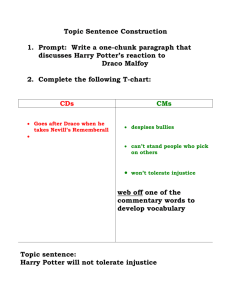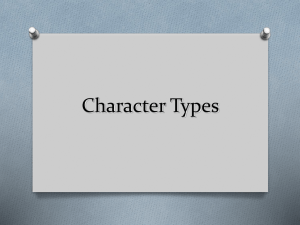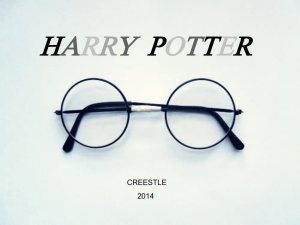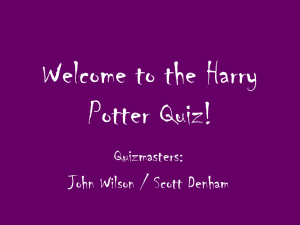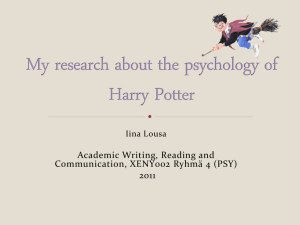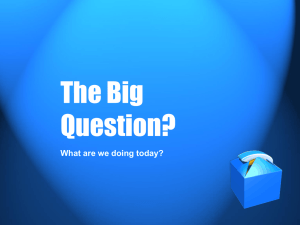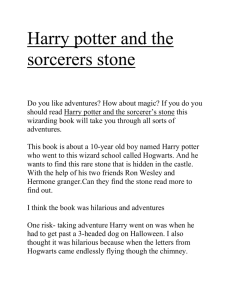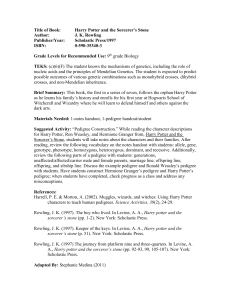Attachment 4
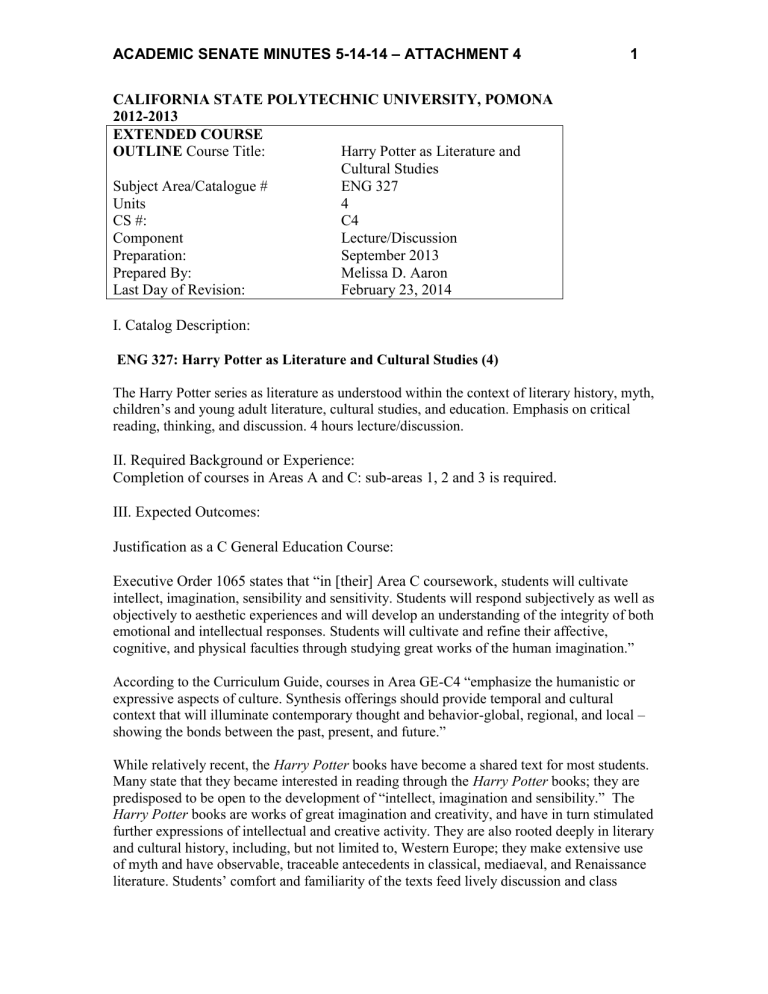
ACADEMIC SENATE MINUTES 5-14-14
– ATTACHMENT 4 1
CALIFORNIA STATE POLYTECHNIC UNIVERSITY, POMONA
2012-2013
EXTENDED COURSE
OUTLINE Course Title: Harry Potter as Literature and
Cultural Studies
Subject Area/Catalogue #
Units
CS #:
Component
Preparation:
Prepared By:
Last Day of Revision:
ENG 327
4
C4
Lecture/Discussion
September 2013
Melissa D. Aaron
February 23, 2014
I. Catalog Description:
ENG 327: Harry Potter as Literature and Cultural Studies (4)
The Harry Potter series as literature as understood within the context of literary history, myth, children’s and young adult literature, cultural studies, and education. Emphasis on critical reading, thinking, and discussion. 4 hours lecture/discussion.
II. Required Background or Experience:
Completion of courses in Areas A and C: sub-areas 1, 2 and 3 is required.
III. Expected Outcomes:
Justification as a C General Education Course:
Executive Order 1065 states that “in [their] Area C coursework,
students will cultivate intellect, imagination, sensibility and sensitivity. Students will respond subjectively as well as objectively to aesthetic experiences and will develop an understanding of the integrity of both emotional and intellectual responses. Students will cultivate and refine their affective, cognitive, and physical faculties through studying great works of the human imagination.”
According to the Curriculum Guide, courses in Area GE-C4 “emphasize the humanistic or expressive aspects of culture. Synthesis offerings should provide temporal and cultural context that will illuminate contemporary thought and behavior-global, regional, and local – showing the bonds between the past, present, and future.”
While relatively recent, the Harry Potter books have become a shared text for most students.
Many state that they became interested in reading through the Harry Potter books; they are predisposed to be open to the development of “intellect, imagination and sensibility.” The
Harry Potter books are works of great imagination and creativity, and have in turn stimulated further expressions of intellectual and creative activity. They are also rooted deeply in literary and cultural history, including, but not limited to, Western Europe; they make extensive use of myth and have observable, traceable antecedents in classical, mediaeval, and Renaissance literature. Students’ comfort and familiarity of the texts feed lively discussion and class
ACADEMIC SENATE MINUTES 5-14-14
– ATTACHMENT 4 2 participation, and demand comprehension and recall of a large segment of material. These in turn provide an opportunity for a more sophisticated analysis of this text, texts in general, and a critical approach to culture.
The texts are also strongly concerned with issues of social justice, including gender studies, considerations of discrimination and social class, and the influence of government and the media. They also explicitly engage with education and with pedagogy itself.
ENG 327 use a particular, relevant, and appealing lens—the Harry Potter books by J.K.
Rowling—as a departure point for inquiry into the full spectrum of literary and cultural history and its relationship to what it means to be an individual human, and a member of humanity. Its seemingly simple surface, familiar to many students through stories of magic candy and scarlet steam locomotives, covers complex topics: quest narrative, sacrificial love, racism, classism, and social justice, to name only a few.
After taking ENG 327, students should be able to evaluate, analyze, think, and write critically, taking skills learned from lower-division courses on literature and applying them in-depth to a particular work and in breadth to the works to which it is related and the cultural framework in which it is situated.
In this course, students investigate literature, gender studies, pedagogy, and popular culture through the lens of J. K. Rowling’s
Harry Potter books and films. It is already offered as an alternative to ENG 326: Young Adult Literature.
Its focus on the works of one author enables an engagement with many larger issues of literacy, literary knowledge, and pedagogy. It is suitable as a C4 synthesis course in its multidisciplinary focus on media studies, cultural studies, sociology, and philosophy.
Upon completion of the course, students should:
A. Be able to identify major literary themes as used in J.K Rowling’s novels, with special reference to historical literary tradition.
B. Be able to identify and analyze literary genres-- bildungsroman, romance, quest, fantasy,
British “school story,” fairy tale, children’s literature/young adult—to which the Harry Potter books belong.
C. Be able to compare and contrast the texts with earlier and contemporary counterparts.
D. Be able to use evidence—in this case, textual evidence--to support interpretation.
E. Be able to relate the texts to relevant historical and cultural topics, such as myth, religion, history, and literary tradition.
F. Be able to relate the texts to relevant contemporary issues, such as popular culture, gender studies, GBLT issues, censorship, and activism.
G. Be able to engage with issues of pedagogy, academics, and education, including critical self-reflection on the students’ own education.
H. Be able to write well-argued critical essays about literary texts, using textual evidence and knowledge of literary history.
I. Be able to conduct research on topics relevant to literary history, genre, and/or popular culture with reference to the works of J. K. Rowling.
ACADEMIC SENATE MINUTES 5-14-14
– ATTACHMENT 4 3
IV. Instructional Materials:
The following texts are required:
Rowling, J. K.
Fantastic Beasts and Where to Find Them . Scholastic, 2001.
The Tales of Beedle the Bard . Scholastic, 2008.
Harry Potter and the Sorcerer’s Stone
. Scholastic, 1997.
Harry Potter and the Chamber of Secrets . Scholastic, 1998.
Harry Potter and the Prisoner of Azkaban . Scholastic, 1999.
Harry Potter and the Goblet of Fire . Scholastic, 2000.
Harry Potter and the Order of the Phoenix . Scholastic, 2003.
Harry Potter and the Half Blood Prince . Scholastic, 2005.
Harry Potter and the Deathly Hallows . Scholastic, 2007.
These texts must be read or re-read prior to the commencement of the course. The texts will be studied and discussed in class sessions, but familiarity with all books will be presumed.
This is consistent with other courses centered on the Harry Potter texts, including Philip
Nels’ at Kansas State University, James Thomas at Pepperdine, and Edmund Kern’s at
Lawrence College.
Instructors may assign additional texts, including but not limited to the following:
“Una candida cerva,” Rime Sparse , Francis Petrarch
“Whose List to Hunt,” Thomas Wyatt
Henry V, William Shakespeare
Le Morte d’Arthur
, Thomas Malory
King James Bible
T. H. White, selections from The Once and Future King, The Book of Beasts
Selections from Sabine Baring Gould, Montague Summers
Judith Butler, Eve Kosofsky Sedgewick, Marjorie Garber.
Perry Nodelman and Mavis Reimer,
The Pleasures of Children’s Literature
Newspaper articles, interviews, and reviews
Anatol, Giselle Liza, ed. Reading Harry Potter: Critical Essays . Contributions to the Study of
Popular Culture 78. Westport, CT, and London: Praeger, 2003.
---. Reading Harry Potter Again: New Critical Essays. Westport, CT, and London: Praeger,
2009.
Jenkins, Henry. Fans, Bloggers, and Gamers: Exploring Participatory Culture. New York,
New York: New York University Press, 2006.
Pinsent, Pat. “The Education of a Wizard: Harry Potter and his Predecessors.” Whited, 27-50.
Teare, Elizabeth Butler. “Harry Potter and the Technology of Magic.” Whited, 329-343.
Tucker, Nicholas. “The Rise and Rise of Harry Potter.” Children’s Literature in Education
30:4 (1999) 221-34.
Whited, Lana A., ed. The Ivory Tower and Harry Potter: Perspectives on a Literary
Phenomenon . Columbia and London: University of Missouri P, 2002.
Selected short clips from the films.
V. Minimum Student Materials:
Required texts in paper or electronic form, writing materials.
Word processing software, printer.
ACADEMIC SENATE MINUTES 5-14-14
– ATTACHMENT 4 4
Online access to course management software, blog entries, online materials, electronic library databases, relevant external sites.
VI. Minimum College Facilities:
Smart classroom with projector and DVD capabilities. Blackboard/whiteboard.
Seating for 30 students, with sufficient room to sit in a circle, which is necessary for effective discussion.
VII. Course Outline:
Week 1
The Boy Who Lived: Origins of Harry Potter . Lecture and discussion of sources and background material: the Bible, Shakespeare, The Once and Future King , Spenser,
Wyatt/Petrarch. Explanation of course procedures and responsibilities. Blog entry due at end of week.
Week 2
Harry Potter and the Sorcerer’s Stone
. The Lion in the Wardrobe and the Cupboard Under the Stairs: relation to Chronicles of Narnia , Lord of the Rings , and their common sources.
Classical, medieval and Renaissance literary references; discussions of alchemical composition and other relevant Renaissance cultural concepts. Blog entry due.
Week 3
Harry Potter and the Deathly Hallows.
“I open at the close”: the end of the story. Literary structure, both book-specific and overall series; parallels to the Gothic and the detective story; genre, including the British school story. Blog entries.
Week 4
Harry Potter and the Prisoner of Azkaban, Fantastic Beasts and Where to Find Them . “Other beasts and beings: J.K. Rowling’s bestiary.” Werewolves, centaurs, unicorns, fairies: mythological beings. Their portrayal in Harry Potter , their sources in history and cultures, their relationship to religion and myth. Research paper topics are due this week.
Weeks 5-6
Harry Potter and the Order of the Phoenix.
Week 5: “ Educational Directives: Harry Potter , pedagogy and censorship.” Harry Potter as a teaching tool and its function in promoting literacy; models for pedagogy and academic administration, positive and negative; and the issues surrounding banned and challenged books. Blog entries .
Week 6: Scheduled session at library on research methodology and materials. Class session on Harry Potter and academia, scholarship, and the growing field of “Potter Studies.”
Week 7
Harry Potter and the Chamber of Secrets. “’My own line of hair care products’: Harry Potter and merchandising.” The Harry Potter franchise and consumer culture, including film, tie-ins, and theme parks. Popular culture and its official packaging and merchandising of entertainment product, as distinct from week 9, below. Preliminary paper due .
Week 8
Harry Potter and the Half-Blood Prince . “’All the wrong people”: romance novels,
“queering” Harry Potter , Harry Potter and gender studies .
” Treatment of “the other,” acceptance and rejection in general, and GBLT issues in specific: why have many GBLT people, especially young people, found such validation in the books? Controversy and activism through groups such as the HP Alliance. Group exchange of papers .
ACADEMIC SENATE MINUTES 5-14-14
– ATTACHMENT 4 5
Week 9
Harry Potter and the Goblet of Fire
.“Pay no attention to the Quill”:
Harry Potter and media coverage. Journalism, positive and negative coverage; fandom, fan conflict, and Fan-created works, as opposed to licensed merchandising, such as Wizard Rock (or “Wrock,”) fanfiction, fan art, convention, and the extent to which the fandom creates or “writes” the text. Draft due .
Week 10
The Tales of Beedle the Bard and Pottermore
. “
Quo vadis
: do the books have a future?” Are they classics? Do they have a permanent spot in children’s and Young Adult literature, in schools, and in the literary canon of “serious books?”
Finals week : Portfolio due, optional final exam.
Adaptation to the semester system for calendar conversion:
This course is valuable to the EFL department, which intends to keep it. It also has a very heavy reading load. While students are expected to have read the required books before the beginning of class, they will also need to re-read them in preparation for class sessions. The multiple submission of a cumulative portfolio will be enhanced by the additional time provided by a semester. The fourteen week time scale is also much better for discussing the seven key books of the series, some of which are several hundred pages long: approximately two weeks per book.
VIII. Instructional Methods:
Lecture with Powerpoint presentations
Class discussion
Individual readings
In-class presentations and group activities
Analyses of texts and multimedia
For organizational purposes, each class session may begin with the book under discussion and then move to the related focus.
IX. Outcomes Assessment:
A.
Evaluation
Attendance and participation: Attendance taken, participation noted. Informal oral presentation required and in-class work in small groups.
Blogs: Cumulative online journal, or “blog,” with regularly scheduled entries and defined prompts.
Quizzes: Short objective quizzes on content and comprehension administered at the beginning of each week.
Research paper: Paper containing a research topic of the student’s choice and approved by the instructor. Topics may relate to cultural studies, pedagogy, literary acquisition, literary analysis, or literary history, among others. Multiple submissions are required, collated into a portfolio. Each submission is required for final grading. Students are subdivided into work groups by topic similarity for collaborative purposes.
Components:
ACADEMIC SENATE MINUTES 5-14-14
– ATTACHMENT 4 6
1. Topic submitted for approval: fourth week of classes.
2. Literature survey and annotated bibliography: seventh week of classes.
3. Group exchange of papers: eighth week of classes.
4. Draft due: ninth week of classes.
5. Portfolio with all pre-writing, multiple submissions, final draft, and cover letter: exam week.
Optional final exam on exam date.
B. General Education Outcomes Assessment
Students will complete departmental evaluations, both quantitative and narrative.
Students will also respond to at least one evaluation during the term, so that the instructor may address concerns and adapt to student needs. The EFL department has recently developed a new evaluation instrument that is very good at assessing student learning patterns and development and means of improving student learning.

